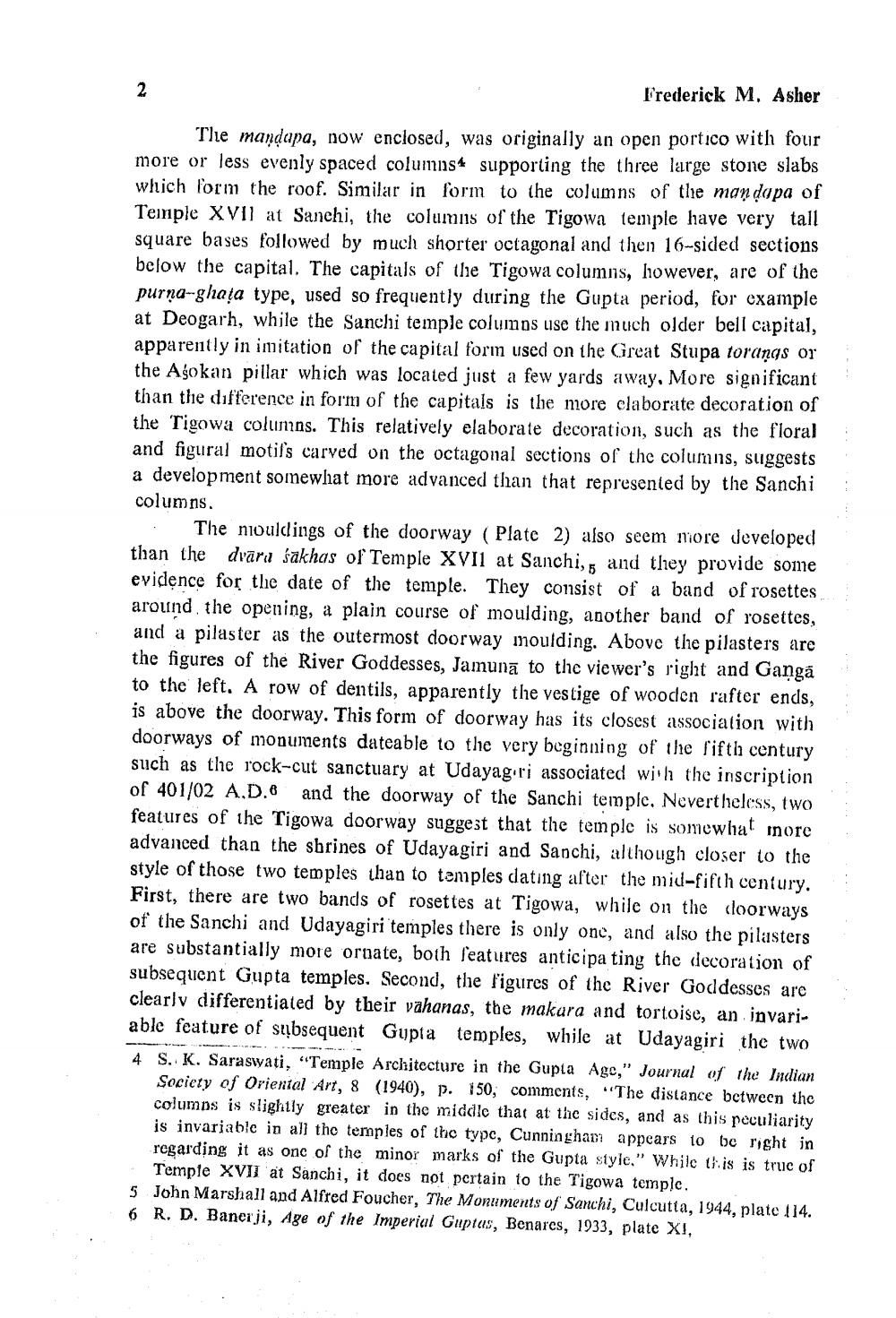Book Title: Sambodhi 1977 Vol 06 Author(s): Dalsukh Malvania, H C Bhayani, Nagin J Shah Publisher: L D Indology Ahmedabad View full book textPage 4
________________ Frederick M. Asher The mandapa, now enclosed, was originally an open portico with four more or less evenly spaced columns supporting the three large stone slabs which form the roof. Similar in form to the columns of the mandapa of Temple XVII at Sanchi, the columns of the Tigowa temple have very tall square bases followed by much shorter octagonal and then 16-sided sections below the capital. The capitals of the Tigowa columns, however, are of the purna-ghata type, used so frequently during the Gupta period, for example at Deogarh, while the Sanchi temple columns use the much older bell capital, apparently in imitation of the capital form used on the Great Stupa torangs or the Asokan pillar which was located just a few yards away. More significant than the difference in form of the capitals is the more elaborate decoration of the Tigowa columns. This relatively elaborate decoration, such as the floral and figural motifs carved on the octagonal sections of the columns, suggests a development somewhat more advanced than that represented by the Sanchi columns. 2 The mouldings of the doorway (Plate 2) also seem more developed than the dvara sakhas of Temple XVII at Sanchi, and they provide some evidence for the date of the temple. They consist of a band of rosettes around the opening, a plain course of moulding, another band of rosettes, and a pilaster as the outermost doorway moulding. Above the pilasters are the figures of the River Goddesses, Jamuna to the viewer's right and Ganga to the left. A row of dentils, apparently the vestige of wooden rafter ends, is above the doorway. This form of doorway has its closest association with doorways of monuments dateable to the very beginning of the fifth century such as the rock-cut sanctuary at Udayagiri associated with the inscription of 401/02 A.D.6 and the doorway of the Sanchi temple. Nevertheless, two features of the Tigowa doorway suggest that the temple is somewhat more advanced than the shrines of Udayagiri and Sanchi, although closer to the style of those two temples than to temples dating after the mid-fifth century. First, there are two bands of rosettes at Tigowa, while on the doorways of the Sanchi and Udayagiri temples there is only one, and also the pilasters are substantially more ornate, both features anticipa ting the decoration of subsequent Gupta temples. Second, the figures of the River Goddesses are clearly differentiated by their vahanas, the makara and tortoise, an invariable feature of subsequent Gupta temples, while at Udayagiri the two 4 S. K. Saraswati, "Temple Architecture in the Gupta Age," Journal of the Indian Society of Oriental Art, 8 (1940), p. 150, comments, "The distance between the columns is slightly greater in the middle that at the sides, and as this peculiarity is invariable in all the temples of the type, Cunningham appears to be right in regarding it as one of the minor marks of the Gupta style." While this is true of Temple XVII at Sanchi, it does not pertain to the Tigowa temple. 5 John Marshall and Alfred Foucher, The Monuments of Sanchi, Culcutta, 1944, plate 114. 6 R. D. Banerji, Age of the Imperial Guptas, Benares, 1933, plate XI,Page Navigation
1 2 3 4 5 6 7 8 9 10 11 12 13 14 15 16 17 18 19 20 21 22 23 24 25 26 27 28 29 30 31 32 33 34 35 36 37 38 39 40 41 42 ... 420
